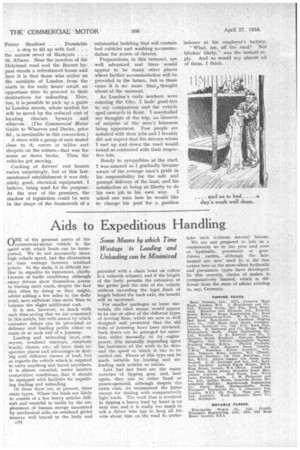Aids to Expeditious Handling
Page 100

If you've noticed an error in this article please click here to report it so we can fix it.
ONE of the greatest assets of the commercial-motor vehicle is the speed. with which loads can be transForted. We do not necessarily mean high vehicle speed, but the elimination ot time wastage between teiminal points. In the main, it is difficult further to expedite its movement, chiefly because of traffic conditions, although many drivers show themselves averse to leaving main roads, despite the fact that often by doing so they might, whilst adding a few miles to the daily total, save sufficient time more than to balance the slight additional cost.
It is not, however, so much with such time-saving that we are concerned in this article, but with means by which excessive delays can be prevented at delivery and loading points either en route or at each end of a journey.
Loading and unloading bays, conveyers, overhead runways, .runabout trucks, chutes, etc., all have their respective places and advantages in dealing with different classes of load, but as regards the vehicle which is required to carry anything and travel anywhere, it is almost essential, under modern competitive conditions, that it should be equipped with facilities for expediting loading and unloading.
Of these there are, at present, three main types. Where the loads are likely to consist of a few heavy articles difficult and 'wasteful to tackle by the employment of human ,energy unassisted by mechanical aids, an overhead girder runway well braced to the body and D34 provided with a chain hoist on rollers is a valuable adjunct, and if the length of the body permits the extension of the girder past the rear of the vehicle without exceeding the legal limit of length behind the back axle, the benefit will be increased.
For smaller packages or loose materials, the ideal means would appear to be one or other of the different types of moving floor, which are now so well designed and protected that the old risks of jamming have been obviated. Such floors can he arranged for operation either manually or by engine power, this naturally depending upon the heaviness of the work to be done and the speed at which it has to be carried out. Floors of this type can be made suitable for loading and unloading such articles as bricks..
Last but not least are the many varieties of tipping gear, and, here again, they can be either hand or power-operated, although despite the extra cost, we recommend the latter except for dealing with comparatively light loads. The work that is involved in tipping a heavy load by hand is no easy one, and it is really too much to ask a driver who has to keep all his wits about him on the road to under
take such arduous manual labour.
We are not prepared to join in a controversy as to the pros and cons at hydraulic, pneumatic or geardriven outfits, although the lastnamed are now used to a far less extent here as the more-silent hydraulic and pneumatic types have developed. In this country, choice of makes is comparatively limited, which is chili:rent from the state of affairs existing in, say, Germany.




















































































































































































